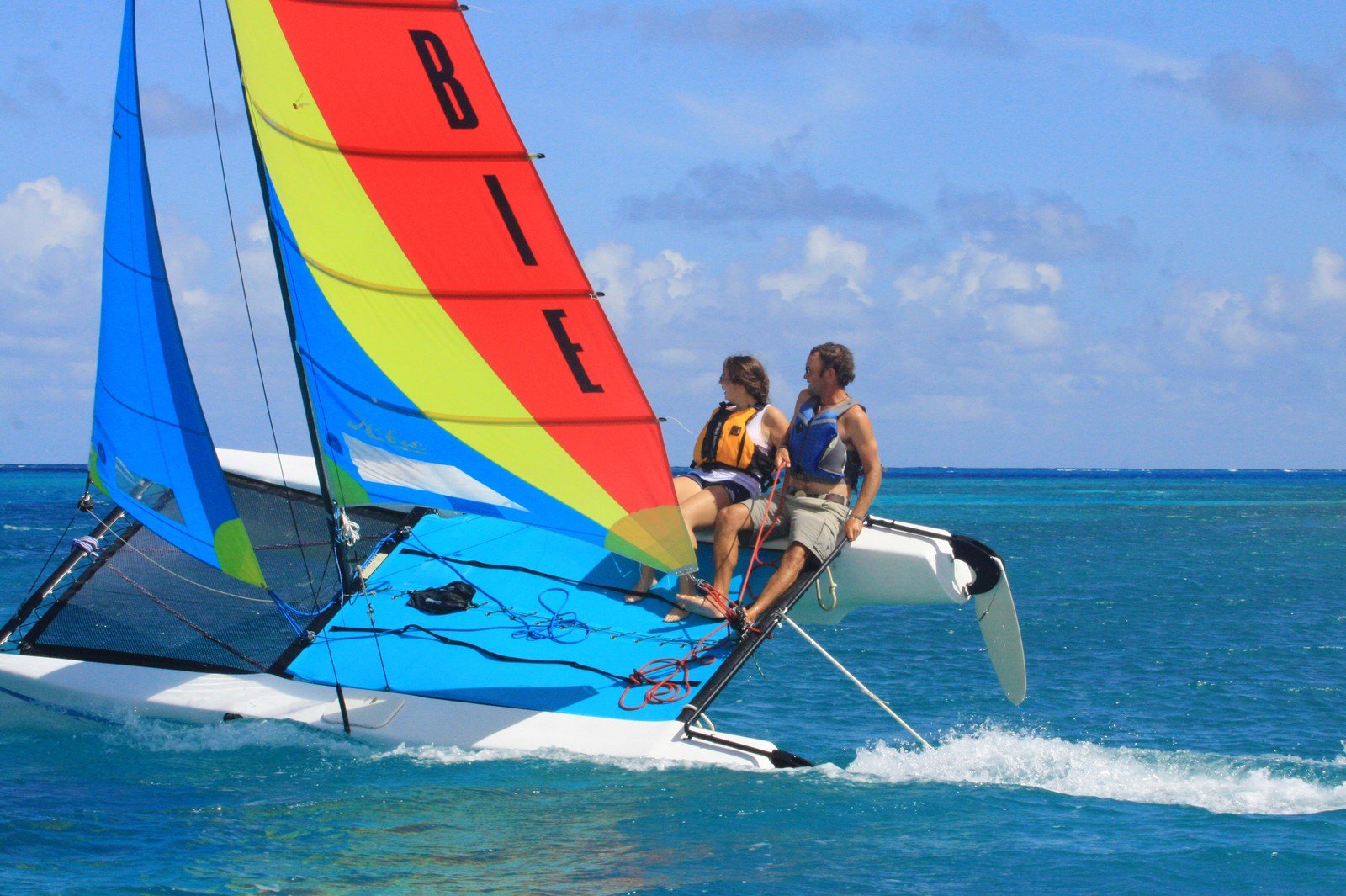General
As with other classes of boats at Westwood, catamaran sailors must hold the appropriate status to be permitted to sail the Hobie 16, Hobie Getaway, or Nacra 500 in the forecast and actual weather conditions. The policy for the Hobie Wave is the same as for the Laser and Albacore.
Granting of Status
There is no catamaran-specific course under the Sail Canada syllabus. In any case, sailing of Westwood’s boats is governed by Westwood. Through long practice and formal policy, Westwood has determined that the preferred method of ensuring safe use of its boats is by establishing a tiered status level, similar to the graduated licensing of drivers. As with other boats, there are three tiers: “Cat Crew”, “Cat Helm”, and “Cat Skipper”. Cat Crew is the status held by any member who does not have status as either a Cat Helm or Cat Skipper, or by any guest (regardless of their actual skill).
Granting of Cat Helm or Cat Skipper status is by the Board of Directors based on the recommendation of Examiners appointed by it (see: Examiners Policy). Cat Helm status may be granted based on the recommendation of a single Examiner; Cat Skipper status requires the recommendation of two Examiners. Cat Helm status (but not Cat Skipper status) may also be recommended by the course instructor for any student who has successfully completed Westwood’s catamaran-specific course (if and when offered). In any case, recommendations must be based on the review of the member’s practical sailing skills and demonstrated attitude towards safe and competent sailing, based on the Examiner’s own experience and knowledge, whether through an intensive exposure or over a period of multiple experiences.
Restrictions
When sailing Westwood’s catamarans, sailors are subject to the following restrictions:
Cat Crew
Crew may only sail with a Cat Helm or Cat Skipper, as appropriate to the conditions. While the skipper of any boat is ultimately responsible for the boat and its crew, no one should sail in contravention of this policy or when they are uncomfortable with the conditions. Cat Crew should tell their boat skipper when they are injured, nervous, tired, cold, or wish to return to the dock.
Cat Helm
Wind Speed as measured at the Toronto Island Airport must be under 15 knots.
Gusting speeds above 18 knots are to be avoided.
Sailing zone is limited to the Outer Harbour and the Inner Harbour. The Outer Harbour is limited by the straight line running from the western seawall of the Eastern Gap, through the red buoy located mid-way between the mainland and the Leslie Spit, to the northern shore of the Leslie Spit.
Cat Skipper
Wind speed is at the reasonable discretion of the Cat Skipper, keeping in mind their – and their crew’s – experience, skills, and current mental and physical condition.
The Skipper must not sail without being able to see land (not including the CN Tower). Consider distance, wind/weather and changes, and boat condition and the potential for breakage. Have a back-up plan.
Sailing onto the lake beyond the Eastern Gap requires at least one of the following:
a buddy boat with a Skipper aboard, which must remain within hailing distance at all times;
waterproof handheld VHF Radio (and appropriate licence), with waterproof GPS; or
personal locator beacon (PLB) with integrated GPS.
Qualifications
The Board of Directors will grant status on the catamarans after receiving the recommendations of the Examiner(s) based on the following qualifications:
Cat Crew
No status granted.
Crew must be forthright about their skills (or lack thereof) so that their Helm or Skipper can assess the overall capability to manage the boat as a team.
Cat Helm (assessment by a single Examiner, including by a Westwood Cat School instructor)
Must have Skipper status on the Albacore.
Cat School passed (or certified by an Examiner)
Understands that a boat’s skipper is legally responsible for the well-being and safety of the crew.
Understands that a boat’s skipper is responsible to provide a safe and enjoyable experience to the crew, and that the crew may have a different expectation of what is safe and enjoyable.
Knows and demonstrates:
use of appropriate clothing and gear and ensures crew is dressed appropriately;
basic boat maintenance skills (plugs, drain, check for wear and tear);
rigging and de-rigging the applicable catamaran;
launching and docking;
tacking and gybing;
hull-flying;
capsize drills, including (when practical to demonstrate) from turtled position; and
single-handed crew overboard drill in up to 15 knots wind speed.
Cat Skipper (independent assessment by two Examiners)
Hold, or be assessed as eligible to hold, Cat Helm status based on the criteria above.
Can do all of the above in in greater than 18 knots wind speed, and in particular, can do a single-handed crew overboard drill in greater than 18 knots wind speed in various sea states.
Can confidently double trap in greater than 18 knots wind speed in various sea states.
Can beach the boat safely.
Can sail under jib alone in greater than 18 knots wind speed in various sea states.
Can assess the seaworthiness of the boat (gudgeons, shrouds, sheets, sails, and bolts) through a pre-sail safety inspection.
Understands basic weather concepts like frontal passages.
Has acquired enough experience with the local weather to properly judge the conditions.
Can plan an outing according to weather conditions, including planning to allow for successful return to shore even with a fast-approaching weather system.
Understands the difference between sailing with other boats on the harbours versus sailing on the open lake and the resulting increased risk of sailing on the open lake. Key points: much colder temperatures; waves; currents and potential offshore wind conditions which prevent a return to shore (e.g., if the main sail fails); exhaustion, dehydration, and hypothermia. Prepares for these eventualities.
Assesses the skill-level of the boat’s crew, instructs the crew (e.g., on how to trapeze – especially without losing the hook) to prevent injury and crew overboard situations, and sails accordingly. Ensures crew is dressed appropriately. In particular, knows and is realistic about own limitations and acts accordingly.
Demonstrates good situational awareness.
Cat Racing
Consult with the Boat Captain to ensure the boat is ready and available for racing.
Westwood does not pay for registrations or catamaran Class fees, mainly because (i) these are individual-based, not boat-based; and (ii) the club has a primary focus on teaching and racing Albacores through membership in the OHSF and CAA. In particular, no one may race an Albacore unless the boat is registered with CAA, and only boat owners can register boats.
Only Cat Skippers may sign out boats for off-site racing, as this requires de-rigging and trailering. Sign-out is in accordance with the applicable policy.
Other References
“Hobie University” – see http://hobieclass.com/hobie-tuning/ or look for a copy in the clubhouse (and please do not remove).
Forums: visit Hobie Forums • Index page which may have helpful information.

